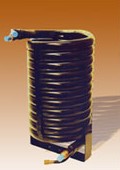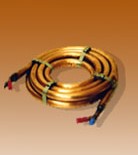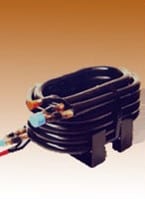Exchangers
Edwards Refrigerant to Liquid Heat Exchangers can be used in many different applications. We are also able to offer many different shape and capacity options including but not limited to:
Here are some advantages to the Edwards Coils Heat Exchanger
Cut water consumption
When used as a refrigerant condenser, the Edwards coaxial counter-flow heat exchanger reduces the consumption of condenser cooling water dramatically because the desuperheating of the refrigerant gas can be performed by the condenser water (in counter-flow the refrigerant) after the refrigerant has been sub-cooled and condensed. With hermetic compressors, this feature is of particular importance since at least 35% of the heat rejection in the condenser is in the superheat region. It is even possible to have the water leave the condenser at a temperature higher than the condensing temperature.
Material flexibility
Applied fin construction permits use of various materials for a wide range of applications: copper, cupro-nickel, stainless steel, and titanium.
Reduce refrigerant charge
Edwards condensers have maximized the available surface area between tubes. This decreases the internal volume of the annulus and thereby the amount of refrigerant required for operation. The smooth bore inner tube with uniform wall provides capacity at lower weight (pounds) per coil.
Low maintenance
Edwards water cooled refrigerant condensers are designed for long life and low cost. They are the most effective heat transfer units available. The smooth bore tube is less prone than an ordinary coaxial heat exchanger to dirt build-up, resulting in longer intervals between regularly scheduled maintenance.
Stabilize capillary Performance
Capillary tubing works best over a wide range of temperatures when operated with tube-in-tube condensers having a low internal refrigerant volume. If the condenser water drops in temperature the head pressure will drop and reduce the pressure available to force the refrigerant through the capillary. With Edwards coaxial condensers the condensing surface at low water temperatures will become flooded with refrigerant and thus reduce the condenser capacity.
Single-wall and double-wall vented
The Advanced Fin line is designed to accommodate single-wall and double wall vented applications, allowing monitoring of the inner tube for potable water applications.
Save space
The unique method of finning developed by Edwards Coils Corp. places more finned surface area in the annulus than any other condenser coil. This increase in internal surface area maximizes heat transfer and allows the use of shorter coil lengths which result in more compact configurations.
Sea water construction
For marine, seawater, or brackish water conditions, all models are available with inner tubes of 90/10 cupro-nickel, titanium and other metals.





